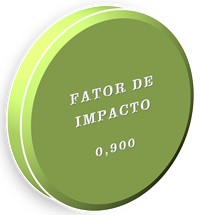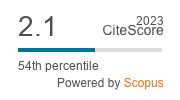MAPEAMENTO ASSOCIATIVO PARA PRODUTIVIDADE DE GRÃOS EM GERMPLASMA EXÓTICO DE SOJA SOB ALTAS TEMPERATURAS
DOI:
https://doi.org/10.1590/1983-21252022v35n307rcPalavras-chave:
Glycine max. Desequilíbrio de ligação. Seleção assistida por marcadores.Resumo
A soja está entre as principais culturas do mundo, pois é uma excelente fonte de proteínas, micronutrientes e óleo. Considerando que o estresse abiótico afeta o agronegócio, acarretando em perdas, a produtividade de grãos da cultura deve ser mantida mesmo sob altas temperaturas. Nesse contexto, o objetivo deste trabalho foi selecionar marcadores relacionados à produtividade da soja, avaliada em altas temperaturas, por meio de mapeamento associativo. A população de mapeamento incluiu 80 PIs de soja e 15 controle. Para a fenotipagem, os genótipos foram avaliados em altas temperaturas em um experimento realizado em Teresina (estado do Piauí) e foram avaliados quatro caracteres de interesse agronômico: altura da planta na maturidade, valor agronômico, peso de 100 sementes e rendimento de grãos. A genotipagem foi realizada por meio da Affymetrix Platform (180 K Axiom® Soybean Genotyping Array) e o desequilíbrio de ligação entre pares de marcadores foi calculado por meio do coeficiente de determinação, por meio do teste de permutação rápida. A análise da associação entre os marcadores e o fenótipo de interesse foi realizada por meio de uma abordagem de modelo linear generalizado, incluindo dados de fenotipagem, marcadores SNP e informações sobre a estrutura populacional. Os resultados revelaram que 34,06% dos loci apresentaram desequilíbrio de ligação significativo (p < 0,001), sendo encontradas 16 associações significativas para os quatro caracteres relacionados à tolerância ao calor. Essas associações podem auxiliar os melhoristas que buscam incorporar a tolerância a altas temperaturas em programas de melhoramento genético da soja via seleção assistida por marcadores.
Downloads
Referências
BARBOSA, E. G. G. et al. Overexpression of the BA-Dependent DREB1 Transcription Factor from Arabidopsis thaliana improves Soybean Tolerance to Water Deficit. Plant Molecular Biology Reporter, 31: 719-730, 2012.
BITA, C. E.; GERATS, T. Plant tolerance to high temperature in a changing environment: scientific fundamentals and production of heat stress-tolerant crops. Frontiers in Plant Science, 4: 1-8, 2013.
BOARD, J. E.; HARVILLE, B. G. Late-planted soybean yield response to reproductive source/sink stress. Crop Science, 38: 763-771, 1998.
BRADBURY, P. J. et al. TASSEL: software for association mapping of complex traits in diverse samples. Bioinformatics, 23: 2633–2635, 2007.
DIDONET, A. D.; VITÓRIA, T. B. Resposta do feijoeiro comum ao estresse térmico aplicado em diferentes estágios fenológicos. Pesquisa Agropecuária Tropical, 36: 199-204, 2006.
DOYLE, J. J.; DOYLE, J. L. A rapid DNA isolation procedure for small quantities of fresh leaf tissure. Phytochemical Bulletin, 19: 11-15, 1987.
EVANNO, G.; REGNAULT, S.; GOUDET, J. Detecting the number of clusters of individuals using the software STRUCTURE: a simulation study. Molecular Ecology, 14: 2611–2620, 2005.
GU, Y.; WU, J. LC–MS/MS coupled with QSAR modeling in characterising of angiotensin I-converting enzyme inhibitory peptides from soybean proteins. Food chemistry, 141: 2682 -2690, 2013.
GUPTA, K. P.; RUSTGI, S.; KULWAL, P. L. Linkage disequilibrium and association studies in higher plants: Present status and future prospects. Plant Molecular Biology, 57: 461–485, 2005.
HIRAKURI, M. H. Perdas econômicas geradas por estresses bióticos e abióticos na produção brasileira de soja no período 2016-2020. 1. ed. Londrina, PR: Embrapa, 2021. 8 p. (Circular Técnica, 168).
HU, Z. et al. Association mapping of yield-related traits and SSR markers in wild soybean (Glycine soja Sieb. and Zucc.). Breeding Science, 63: 441-449, 2014.
HWANG, E. et al. A genome-wide association study of seed protein and oil content in soybean. BMC Genomics, 15: 1-12, 2014.
KANG, Y. J. et al. Genome-wide mapping of NBS-LRR genes and their association with disease resistance in soybean. BMC Plant Biology, 12: 1-13, 2012.
KORIR, P. C. et al. Association mapping combined with linkage analysis for aluminum tolerance among soybean cultivars released in Yellow and Changjiang River Valleys in China. Theoretical Applied Genetics, 126: 1659–1675, 2013.
LAMKEY, C. M.; HELMS, T. C.; GOOS, R. J. Marker-assisted versus phenotypic selection for iron deficiency chlorosis in soybean. Euphytica, 194: 67–78, 2013.
LIU, X. J.; JIAN, W.; GUANGHUA, S. J. H. Soybean yield physiology and development of high- yielding practices in Northeast China. Field Crops Research, 105: 157-171, 2008.
MAO, T. et al. Association mapping of loci controlling genetic and environmental interaction of soybean flowering time under various photo-thermal conditions. BMC Genomics, 18: 1-17, 2017.
NIU, Y. et al. Association mapping for seed size and shape traits in soybean cultivars. Molecular Breeding, 31: 785–794, 2013.
PELLEGRINO, G. Q.; ASSAD, E. D.; MARIN, F. R. Mudanças climáticas globais e a agricultura no Brasil. Revista Multiciência, 8: 139-162, 2007.
PRASSAD, P. V. V. et al. Super optimal temperatures are detrimental to Peanut (Arachis hypogaea L.) reproductive processes and yield at both ambient and elevated carbon dioxide. Global Change Biology, 9: 1775-1787, 2003.
PRIOLLI, R. H. G. et al. Genome analysis to identify SNPs associated with oil content and fatty acid components in soybean. Euphytica, 215: 1-14, 2019.
PRITCHARD, J. K. et al. Association Mapping in Structured Populations. The American Journal of Human Genetics, 67: 170–181, 2000.
POLETTO, M. Maleated soybean oil as coupling agent in recycled polypropylene/wood flour composites: Mechanical, thermal, and morphological properties. Journal of Thermoplastic Composite Materials, 32: 1056-1067, 2019.
QIU, L. J. et al. The worldwide utilization of the Chinese soybean germplasm collection. Plant Genetic Resources: Characterization and Utilization, 9: 109–122, 2011.
RESENDE, M. D. V. Genética Quantitativa e Seleção no melhoramento de Plantas Perenes e Animais. 1. ed. Colombo, PR: Embrapa Florestas, 2008. 330 p.
ROCHA, R. S. et al. Desempenho agronômico de variedades e linhagens de soja em condições de baixa latitude em Teresina-PI. Revista Ciência Agronômica, 43: 154-162, 2012.
RUDDLE, P. et al. Effect of a novel mutation in a Δ9-stearoyl-ACP-desaturase on soybean seed oil composition. Theoretical and applied genetics, 126: 241-249, 2013.
SAÏDOU, A. A. et al. Association mapping, patterns of linkage disequilibrium and selection in the vicnity of the PHYTOCHROME C gene in pearl millet. Theoretical and Applied Genetics, 127: 19–32, 2014.
SAS INSTITUTE. SAS language and procedures: usage. Version 9.0. Cary, 2002.
THUZAR, M. et al. The Effects of Temperature Stress on the Quality and Yield of Soya Bean [(Glycine max L.) Merrill.]. Journal of Agricultural Science, 2: 172-179, 2010.
WU¨RSCHUM, T. et al. Population structure, genetic diversity and linkage disequilibrium in elite winter wheat assessed with SNP and SSR markers. Theoretical and Applied Genetics, 126: 1477-1486, 2013.
ZIEMS, L. A. et al. Association mapping of resistance to Puccinia hordei in Australian barley breeding germplasm. Theoretical and Applied Genetics, 127: 1199–1212, 2014.
ZHU, C. et al. Status and prospects of association mapping in plants. The Plant Genome, 1: 5-20, 2008.
Downloads
Publicado
Edição
Seção
Licença
Os Autores que publicam na Revista Caatinga concordam com os seguintes termos:
a) Os Autores mantêm os direitos autorais e concedem à revista o direito de primeira publicação, com o trabalho simultaneamente licenciado sob a Licença Creative Commons do tipo atribuição CC-BY, para todo o conteúdo do periódico, exceto onde estiver identificado, que permite o compartilhamento do trabalho com reconhecimento da autoria e publicação inicial nesta revista, sem fins comerciais.
b) Os Autores têm autorização para distribuição não-exclusiva da versão do trabalho publicada nesta revista (ex.: publicar em repositório institucional ou como capítulo de livro), com reconhecimento de autoria e publicação inicial nesta revista.
c) Os Autores têm permissão e são estimulados a publicar e distribuir seu trabalho online (ex.: em repositórios institucionais ou na sua página pessoal) a qualquer ponto antes ou durante o processo editorial, já que isso pode gerar alterações produtivas, bem como aumentar o impacto e a citação do trabalho publicado (Veja O Efeito do Acesso Livre).







